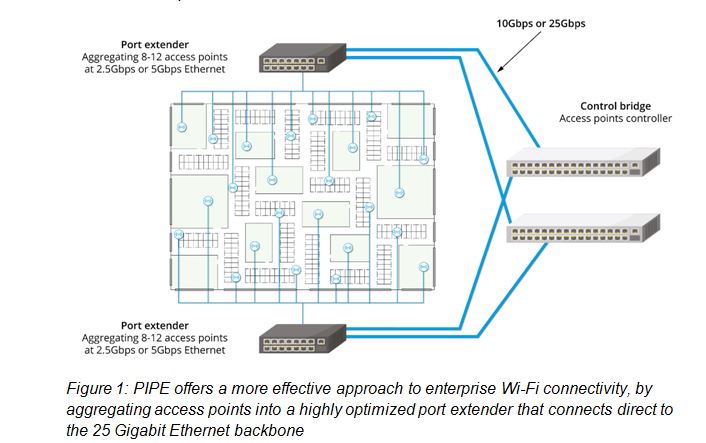

By Yaron Zimmerman, Senior Staff Product Line Manager, Marvell
In order to benefit from the greater convenience offered for employees and more straightforward implementation, office environments are steadily migrating towards wholesale wireless connectivity. Thanks to this, office staff will no longer be limited by where there are cables/ports available, resulting in a much higher degree of mobility. It will mean that they can remain constantly connected and their work activities won’t be hindered - whether they are at their desk, in a meeting or even in the cafeteria. This will make enterprises much better aligned with our modern working culture - where hot desking and bring your own device (BYOD) are becoming increasingly commonplace.
The main dynamic which is going to be responsible for accelerating this trend will be the emergence of 802.11ac Wave 2 Wi-Fi technology. With the prospect of exploiting Gigabit data rates (thereby enabling the streaming of video content, faster download speeds, higher quality video conferencing, etc.), it is clearly going to have considerable appeal. In addition, this protocol offers extended range and greater bandwidth through multi-user MIMO operation - so that a larger number of users can be supported simultaneously. This will be advantageous to the enterprise, as less access points per users will be required. 
An example of the office floorplan for an enterprise/campus is described in Figure 1 (showing a large number of cubicles and also some meeting rooms too). Though scenarios vary, generally speaking an enterprise/campus is likely to occupy a total floor space of between 20,000 and 45,000 square feet. With one 802.11ac access point able to cover an area of 3000 to 4000 square feet, a wireless office would need a total of about 8 to 12 access points to be fully effective. This density should be more than acceptable for average voice and data needs. Supporting these access points will be a high capacity wireline backbone.
Increasingly, rather than employing traditional 10 Gigabit Ethernet infrastructure, the enterprise/campus backbone is going to be based on 25 Gigabit Ethernet technology. It is expected that this will see widespread uptake in newly constructed office buildings over the next 2-3 years as the related optics continue to become more affordable. Clearly enterprises want to tap into the enhanced performance offered by 802.11ac, but they have to do this while also adhering to stringent budgetary constraints too. As the data capacity at the backbone gets raised upwards, so will the complexity of the hierarchical structure that needs to be placed underneath it, consisting of extensive intermediary switching technology. Well that’s what conventional thinking would tell us.
Before embarking on a 25 Gigabit Ethernet/802.11ac implementation, enterprises have to be fully aware of what all this entails. As well as the initial investment associated with the hardware heavy arrangement just outlined, there is also the ongoing operational costs to consider. By aggregating the access points into a port extender that is then connecting directly to the 25 Gigabit Ethernet backbone instead towards a central control bridge switch, it is possible to significantly simplify the hierarchical structure - effectively eliminating a layer of unneeded complexity from the system.
Through its Passive Intelligent Port Extender (PIPE) technology Marvell is doing just that. This product offering is unique to the market, as other port extenders currently available were not originally designed for that purpose and therefore exhibit compromises in their performance, price and power. PIPE is, in contrast, an optimized solution that is able to fully leverage the IEEE 802.1BR bridge port extension standard - dispensing with the need for expensive intermediary switches between the control bridge and the access point level and reducing the roll-out costs as a result. It delivers markedly higher throughput, as the aggregating of multiple 802.11ac access points to 10 Gigabit Ethernet switches has been avoided. With fewer network elements to manage, there is some reduction in terms of the ongoing running costs too.
PIPE means that enterprises can future proof their office data communication infrastructure - starting with 10 Gigabit Ethernet, then upgrading to a 25 Gigabit Ethernet when it is needed. The number of ports that it incorporates are a good match for the number of access points that an enterprise/campus will need to address the wireless connectivity demands of their work force. It enables dual homing functionality, so that elevated service reliability and resiliency are both assured through system redundancy. In addition, supporting Power-over-Ethernet (PoE), allows access points to connect to both a power supply and the data network through a single cable - further facilitating the deployment process.
By Maen Suleiman, Senior Software Product Line Manager, Marvell
First-of-its-kind community platform makes ARM-64bit accessible for data center, networking and storage solutions developers
As network infrastructure continues to transition to Software-Defined Networking (SDN) and Network Functions Virtualization (NFV), the industry is in great need of cost-optimized hardware platforms coupled with robust software support for the development of a variety of networking, security and storage solutions. The answer is finally here!
Now, with the shipping of the Marvell MACCHIATObin™ community board, developers and companies have access to a high-performance, affordable ARM®-based platform with the required technologies such as an ARMv8 64bit CPU, virtualization, high-speed networking and security accelerators, and the added benefit of open source software. SolidRun started shipping the Marvell MACCHIATObin community board in March 2017, providing an early access of the hardware to open-source communities.
Click image to enlarge
The Marvell MACCHIATObin community board is a mini-ITX form-factor ARMv8 64bit network- and storage-oriented community platform. It is based on the Marvell® hyperscale SBSA-compliant ARMADA® 8040 system on chip (SoC) (http://www.marvell.com/embedded-processors/armada-80xx/) that features quad-core high-performance Cortex®-A72 ARM 64bit CPUs
Together with the quad-core Cortex-A72 ARM64bit CPUs, the Marvell MACCHIATObin community board provides two 10G Ethernet interfaces, three SATA 3.0 interfaces and support for up to 16GB of DDR4 memory to handle higher performance data center applications. This power does not come at the cost of affordability: the Marvell MACCHIATObin community board is priced at $349. As a result, it is the first affordable high-performance ARM 64bit networking and storage community platform of its kind.
The Marvell MACCHIATObin community board is easy to deploy. It uses the compact mini-ITX form factor enabling developers and companies to purchase one of the many cases based on the popular standard mini-ITX case to meet their requirements. The ARMADA 8040 SoC itself is SBSA- compliant to offer unified extensible firmware interface (UEFI) support. You can find the full specification at: http://wiki.macchiatobin.net/tiki-index.php?page=About+MACCHIATObin.
To provide the Marvell MACCHIATObin community board with ready-made support for the open-source platforms used in SDN, NFV and similar applications, Marvell is upstreaming MACCHIATObin software support to the Linux kernel, U-Boot and UEFI, and is set to upstream and open the Marvell MACCHIATObin community board for ODP and DPDK support.
In addition to upstreaming the MACCHIATObin software support, Marvell added MACCHIATObin support to the ARMADA 8040 SDK and plans to make the ARMADA 8040 SDK publicly available. Many of the ARMADA 8040 SDK components are available at: https://github.com/orgs/MarvellEmbeddedProcessors/.
For more information about the many innovative features of the Marvell MACCHIATObin community board, please visit: http://wiki.macchiatobin.net. To place an order for the Marvell MACCHIATObin community board, please go to: http://macchiatobin.net/.